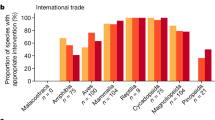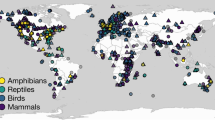Abstract
Despite the growing numbers of threatened species and high levels of spending on their recovery worldwide, there is surprisingly little evidence about which conservation approaches are effective in arresting or reversing threatened species declines. Using two government data sets, we examined associations between population trends for 841 nationally-threatened terrestrial species in Australia, and four measures of conservation effort: (a) how much their distribution overlaps with strictly protected areas (IUCN I–IV), (b) and other protected areas (IUCN V–VI), (c) the number of recovery activities directed at the species, and (d) numbers of natural resource conservation activities applied in areas where populations of the threatened species occur. We found that all populations of 606 (72%) species were in decline. Species with greater distributional overlap with strictly protected areas had proportionately more populations that were increasing or stable. This effect was robust to geographic range size, data quality differences and extent of protection. Measures other than strictly protected areas showed no positive associations with stable or increasing trends. Indeed, species from regions with more natural resource conservation activities were found to be more likely to be declining, consistent with differential targeting of such generalised conservation activities to highly disturbed landscapes. Major differences in trends were also found among the different jurisdictions in which species predominantly occurred, which may be related to different legislative protections against habitat destruction. Although we were not able to test causation, this research corroborates other evidence that protected areas contribute to the stabilization or recovery of threatened species, and provides little empirical support for other conservation approaches.

Similar content being viewed by others
References
Agardy T, Bridgewater P, Crosby MP et al (2005) Dangerous targets? Unresolved issues and ideological clashes around marine protected areas. Aquat conserv 13:4353–4367
Baillie JEM, Hilton-Taylor C, Stuart SN (eds) (2004) 2004 IUCN red list of endangered species: a global species assessment. IUCN, Gland
Bottrill MC, Joseph LN, Carwardine J et al (2008) Is conservation triage just smart decision-making? Trends Ecol Evol 23:649–654
Bottrill MC, Joseph LN, Carwardine J et al (2009) Finite conservation funds mean triage is unavoidable. Trends Ecol Evol 24:183–184
Boyd C, Brooks TM, Butchart SHM et al (2008) Spatial scale and the conservation of endangered species. Conserv Lett 1:37–43
Bruner AG, Gullison RE, Rice RE, da Fonseca GAB (2001) Effectiveness of parks in protecting tropical biodiversity. Science 291:125–128
Carrillo E, Wong G, Cuaron AD (2000) Monitoring mammal populations in Costa Rican protected areas under different hunting restrictions. Conserv Biol 14:1580–1591
Craigie ID, Baillie JEM, Balmford A, Carbone C, Collen B, Green RE, Hutton JM (2010) Large mammal population declines in Africa’s protected areas. Biol Conserv. doi:10.1016/j.biocon.2010.06.007
Department of the Environment Water Heritage and the Arts (2007) 2006–7 Natural Heritage Trust annual report. Australian Government, Canberra
Department of the Environment Water Heritage and the Arts (2008a) Caring for our country business plan 2009–2010. Australian Government, Canberra
Department of the Environment Water Heritage and the Arts (2008b) Collaborative Australian protected areas database, 2006 release. Australian Government, Canberra
Department of the Environment Water Heritage and the Arts (2008c) Species and Communities of National Environmental Significance. Unpublished database, 2008 release, Australian Government, Canberra
Department of the Environment Water Heritage and the Arts (2009a) Assessment of Australia’s terrestrial biodiversity 2008. Australian Government, Canberra
Department of the Environment Water Heritage and the Arts (2009b) Australia’s strategy for the national reserve system 2009–2030. Australian Government, Canberra
Dudley N (ed) (2008) Guidelines for applying protected area management categories. IUCN, Gland, Switzerland
Environment Australia (2000) Revision of the interim biogeographic regionalisation for Australia (IBRA) and development of Version 5.1. Australian Government, Canberra
Ferraro PJ, Pattanayak SK (2006) Money for nothing? A call for empirical evaluation of biodiversity conservation investments. PLoS Biol 4:482–488
Gaston KJ, Jackson SF, Cantú-Salazar L, Cruz-Piñón G (2008) The ecological performance of protected areas. Ann Rev Ecol Evol Sys 39:93–113
Hails C, Humphrey S, Loh J, Goldfinger S (eds) (2009) Living planet report 2008. WWF-International, Gland
Halpern BS, Warner RR (2003) Marine reserves have rapid and lasting effects. Ecol Lett 5:361–366
Hamblin A (2001) Land theme: state of the environment 2001. Australian Government, Canberra
IUCN (2010) IUCN Red list of threatened species. Version 2010.4. http://www.iucnredlist.org. Accessed 27 October 2010
Joppa LN, Pfaff A (2009) High and far: biases in the location of protected areas. PLoS One 4:e8273
Kaiser MJ (2005) Are marine protected areas a red herring or fisheries panacea? Can J Fish Aquat Sci 62:1194–1199
Kalamandeen M, Gillson L (2007) Demything “wilderness”: implications for protected area designation and management. Biodiv Conserv 16:165–182
Kingsford RT, Watson JE, Lundquist CJ et al (2009) Major conservation policy issues for biodiversity in Oceania. Conserv Biol 23:834–840
Lindenmayer DB, Dovers S, Olsen H, Morton S (2008) Ten commitments: reshaping the Lucky Country’s environment. CSIRO Publishing, Melbourne
Little RJA, Rubin DB (1987) Statistical analysis with missing data. John Wiley and Sons, New York
Mackey GB, Watson JEM, Hope G (2008) Climate change, biodiversity conservation, and the role of protected areas: an Australian perspective. Biodiversity 9:11–18
McDonald-Madden E, Gordon A, Wintle BA et al (2009) “True” conservation progress. Science 323:43–44
Owens IPF, Bennett PM (2000) Ecological basis of extinction risk in birds: habitat loss versus human persecution and introduced predators. PNAS 97:12144–12148
Parmesan C (2006) Ecological and evolutionary responses to recent climate change. Ann Rev Ecol Evol Syst 37:637–669
Pearce DW, Putz F, Vanclay JK (2005) Sustainable forestry in the tropics: panacea or folly? In: Sayer JA (ed) The earthscan reader in forestry and development. Earthscan, London
Reed SE, Merenlender AM (2008) Quiet, nonconsumptive recreation reduces protected area effectiveness. Conserv Lett 1:146–154
Sattler PS, Creighton C (2002) Australian terrestrial biodiversity assessment, Australian Government National Land and Water Resources Audit, Canberra. http://adl.brs.gov.au/anrdl/metadata_files/pa_badesr9nn__02211a01.xml. Accessed 22 Dec 2009
Sattler PS, Taylor MFJ (2008) Building nature’s safety net 2008: progress on directions for the national reserve system. WWF-Australia, Sydney
Segan DB, Carwardine J, Klein C et al (2010) Can we determine conservation priorities without clear objectives? Biol Conserv 143:2–4. doi:10.1016/j.biocon.2009.09.014
Selig ER, Bruno JF (2010) A global analysis of the effectiveness of marine protected areas in preventing coral loss. PLoS One 5:e9278. doi:10.1371/journal.pone.0009278
Sokal RR, Rohlf FJ (1995) Biometry: the principles and practice of statistics in biological research, 3rd edn. W. H. Freeman and Co, New York
StataCorp (2003) Stata statistical software: release 8. StataCorp, College Station
Stewart GB, Kaiser MJ, Côté IM et al (2009) Temperate marine reserves: global ecological effects and guidelines for future networks. Conserv Lett 2:243–253
Taylor MFJ, Suckling KS, Rachlinski JJ (2005) The effectiveness of the endangered species act: a quantitative analysis. BioScience 55:360–367
Taylor MFJ, Adams VM, Segan DB, Pressey RL (2009) 20 million hectares by 2020: protected areas, green infrastructure and green jobs for Queensland. WWF-Australia, Sydney
Vanclay JK (2001) The effectiveness of parks. Science 293:1007
Watson JE, Evans MC, Carwardine J et al (2010) The capacity of Australia's protected-area system to represent threatened species. Conserv Biol. doi:10.1111/j.1523-1739.2010.01587.x
Whitfield SM, Bell KE, Philippi T et al (2007) Amphibian and reptile declines over 35 years at La Selva, Costa Rica. PNAS 104:8352–8356
Wilshusen PR, Brechin SR, Fortwangler CL, West PC (2002) Reinventing a square wheel: critique of a resurgent “protection paradigm” in international biodiversity conservation. Soc Nat Res 15:17–40
Woinarski J, Mackey B, Nix H, Traill B (2007) The nature of northern Australia: natural values, ecological processes and future prospects. Australian National University E-press, Canberra
Woinarski JCZ, Milne DJ, Wanganeen G (2001) Changes in mammal populations in relatively intact landscapes of Kakadu National Park, Northern Territory, Australia. Austral Ecol 26:360–370
Acknowledgments
Financial support for this work came from WWF-Australia, the Telstra corporation, the Australian Research Council and a Commonwealth Environmental Research Facility. The Australian Government provided crucial data for the analysis.
Author information
Authors and Affiliations
Corresponding author
Rights and permissions
About this article
Cite this article
Taylor, M.F.J., Sattler, P.S., Evans, M. et al. What works for threatened species recovery? An empirical evaluation for Australia. Biodivers Conserv 20, 767–777 (2011). https://doi.org/10.1007/s10531-010-9977-8
Received:
Accepted:
Published:
Issue Date:
DOI: https://doi.org/10.1007/s10531-010-9977-8




